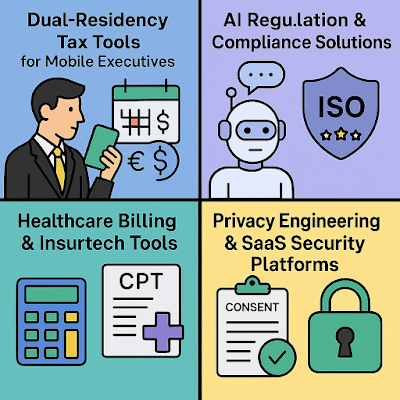Smart SaaS Solutions for Cross-Border Compliance, AI Regulation, and Medical Billing in 2025
Smart SaaS Solutions for Cross-Border Compliance, AI Regulation, and Medical Billing in 2025
Ever tried explaining to your finance team why your pension transfer got flagged by both HMRC and the IRS? I have—twice. That’s when I knew we needed better tools for the mobile executive era.
Welcome to 2025, where dual-taxation nightmares, AI audit traps, and out-of-network billing chaos collide—and where smart SaaS tools are quietly saving careers (and sanity).
This isn't another listicle. This is your toolkit for surviving and thriving in high-stakes, high-regulation industries.
📑 Table of Contents
- 🌍 Dual-Residency Tax Tools for Mobile Executives
- 🧠 PromptOps & AI Compliance Engines
- 🏥 Healthcare Billing & Insurtech Integrators
- 🔐 Privacy Engineering & SaaS Risk Frameworks
🌍 Dual-Residency Tax Tools for Mobile Executives
I had a client last year—CEO of a biotech firm—who split time between London and Miami. When the IRS and HMRC both wanted a piece of his bonus, we realized spreadsheets weren’t cutting it anymore.
That’s when we deployed a Dual-Residency Tax Treaty Eligibility Scanner. Within minutes, the tool identified tie-breaker clauses in the UK-US tax treaty that neither side’s accountant had caught.
These scanners now evaluate residence conflicts using AI-assisted logic trees. They analyze tax home, habitual abode, citizenship hierarchy, and even historical filing behavior to recommend treaty benefits—without triggering red flags.
Alongside this, Pension Transfer Timing Optimizers are changing the game. These tools monitor thresholds, reporting cycles, and bilateral tax treatment on SIPP and QROPS plans. They flag ideal windows for pension movement—before IRS catch-up rules kick in or HMRC closes a tax year retroactively.
If you're advising a cross-border client, don’t rely on back-of-the-envelope math. These tools make treaty coordination a proactive move, not a cleanup job.
🧠 PromptOps & AI Compliance Engines
A few months ago, I sat with a compliance director from a fintech unicorn who looked me straight in the eye and said, "I have no idea what my model is saying to users." That’s a problem.
Luckily, the solution is no longer theoretical. Prompt Chain Review Engines are here, and they’re quietly becoming the AI compliance officer’s best friend. They break down every transformation in a prompt pipeline—from input, to reformulation, to output—and log it with context, timestamps, and in some cases, even legal risk scores.
Think of it like a black box recorder for AI. Except you don’t need a plane crash to open it.
Now, let’s talk hygiene. No one wants their LLM spitting out profanity, bias, or off-label medical advice. That’s where Token-Level Prompt Profanity Filters shine. These tools use real-time scanning of generative output at the token level—especially critical for healthcare, law, and finance deployments where regulation is as thick as a tax code.
And if you’re working in the EU? You’ll want GDPR-Compliant Prompt Logging Infrastructure. This ensures that all prompt interactions are retained, region-locked, and anonymized per EU standards. No more asking, “Where was that prompt stored?” in front of a regulator. You’ll know. Precisely.
I once advised an LLM-powered legal chatbot company. One prompt leak would’ve triggered GDPR fines that could fund a small university. These tools prevented it—and kept the board breathing easy.
🏥 Healthcare Billing & Insurtech Integrators
I still remember a conversation with a sleep clinic operator in Arizona who told me, “We’re delivering top-tier care, but getting paid feels like gambling blindfolded.” And honestly, that sums up U.S. medical billing.
Thankfully, there are now smarter ways to play the game. Smart CPT Groupers are AI-driven tools that classify emerging care models—like digital therapeutics, remote monitoring, and concierge packages—into billable clusters aligned with current payer systems. This isn't just about coding; it’s about getting reimbursed for innovation.
Then there's the monster under the bed: out-of-network pricing. Revenue Cycle Management Estimators now integrate real-time market rates, payer-negotiated fee schedules, and plan tiering to provide estimate ranges patients can actually understand. Goodbye to sticker shock—or at least some of it.
Ever dealt with Medicaid across three states? I have, and the denial rates were brutal—until we brought in Denial Trend Classifiers. These tools crunch your claims data and flag emerging rejection patterns per payer, plan, and CPT pairing. They even predict which denial reason is gaining momentum—so you can appeal before the axe drops.
And for providers who serve dual-eligibles (Medicare + Medicaid)? Automated Gap Coverage Scenario Planners now model reimbursement risk and opportunity based on actual benefit crossover patterns. It’s like a map through the swamp of secondary coverage.
🔐 Privacy Engineering & SaaS Risk Frameworks
If you’ve ever had a deal stall because procurement asked “Where’s our customer data stored?” — welcome to the new normal. SaaS providers must now navigate a patchwork of privacy requirements, often without a dedicated privacy officer on deck.
That’s where Data Residency Reconciliation Platforms come in. These systems help remote-first teams map their storage locations against jurisdictional risk—helping you stay compliant with everything from GDPR to Brazil’s LGPD to California’s CPRA.
Consent Lifecycle Sync Engines are also essential. Whether users are opting in through a website, app, or affiliate channel, this tool tracks and updates their permissions in a centralized, time-stamped ledger. Bonus: it plays nicely with most CMPs (consent management platforms).
Enterprise buyers will love Smart SaaS Risk Matrix Builders. They assess credential sprawl, admin overlap, and shadow IT—all major issues in midsize tech firms with explosive tool adoption.
And when something does go wrong? Breach Notification Compliance Simulators walk you through incident response requirements by jurisdiction. You’ll know if New York demands 72-hour notice and what your EU email template should say—before panic sets in.
Keywords: data residency compliance, privacy engineering SaaS, breach simulator, consent sync engine, SaaS procurement risk
